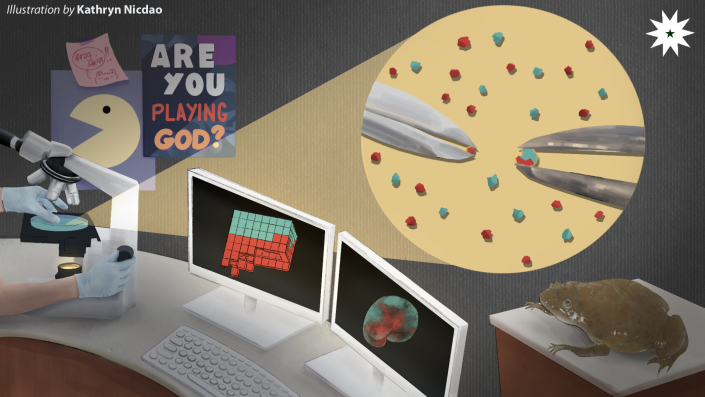When we think of robots, characters like WALL-E pop into mind—boxy droids with metal claws for hands that function to clean, to cook, to navigate, and to do anything we program them to. It seems, however, that the idea of what a robot is is changing as developments in biotechnology suggest a different path: programmable life forms that are bereft of computer chips, steel, and wires.

Command blocks
Xenobots are Pacman-shaped blocks of frog skin stem cells arranged into a specific three-dimensional layout. Douglas Blackiston, a senior scientist at the Allen Discovery Center at Tufts University, explains that he collects these cells, connects them, and designs them with the help of a computer.
The process involves iterating through designs using a simulation guided by artificial intelligence (AI). This simulated environment features xenobot-representative cubes in a three-dimensional environment that are observed in the presence of gravity, water, and springs. Within each of these are smaller cubes that represent different real-life cell types, such as those that generate the functions of an organ.
Michael Levin, director of the Allen Discovery Center, explains that maps of cell properties are “fed” into these cubes. The AI then predicts the behavior of thousands of distinctly shaped xenobots, testing random combinations one after another. Once the designs move as desired, they use them to build the xenobots in the laboratory.
Here, they isolate the skin layers of the stem cells, put them together, and sculpt them to the right shape. Finally, they are put to the test: the built xenobots are placed in a petri dish, observed, and exposed to more environments such as tubes of various sizes.
Xenobots take a few days to mature and live for about a week without food before “dying.” Blackiston adds that the “lifespan” of a xenobot can be extended by either growing them at cold temperatures or growing them in nutrient-rich media. They may even survive for months at a time under the right conditions.
Nature’s calling
Xenobots are currently able to perform rudimentary actions such as moving in a straight line, responding to stimuli, and carrying microscopic objects even when they do not have any neurons or other communicative organs. Everything they do is mindless, uncoordinated, and out of their nature as cells.
These are the products of what Blackiston calls a “bottom-up design”. Researchers provide organizational cues and these biobots mostly function as called by their innate abilities. He likens this to how one issues a command to a computer—the algorithm responds on its own and a user needs not to encode programs in binary.
Following the xenobots’ natural features ensures that they are not surprised by injury. As they are aggregates of skin cells, they can mend themselves. Thanks to their design and shape, there is another ability that xenobots have: self-replication.
Levin affirms that this self-replication is done by “relying on the cells’ natural agenda.” Assuming an influx of frog skin cells, the “mouths” of these Pacman-shaped biobots allow them to “eat” and “collect” cells in their way. “They [spontaneously] corral those into small piles, and the piles turn into xenobots,” he posits.
Defining the future
The development of xenobots has paved an entirely new discipline at the interface of biology and robotics. By working on these entirely new forms of robots, researchers anticipate that their applications could range from scraping clots in arteries to collecting microplastics in the ocean.
As exciting as xenobots sound, however, their future implications will have to hold. In medicine alone, Blackiston laments that “the path for humans is always slow,” and that what occurs in vitro does not always parallel the real world. Aside from this, xenobots are a premature technology; scientific literature on their practical applications is non-existent.
In the quest for demystifying natural systems, Blackiston ponders on what happens when biological plasticity is leveraged to build an entire organism. He furthers, “If you can rearrange [cells], put them into different forms, sort of rebuild them, and they survive, could you build [a new organism] from the ground up?”
Once these cells successfully animate their structure into another form, new doors in biotechnology and longevity will be opened—enabling scientists to create whatever is possible in a petri dish. “The knowledge we gain from studying xenobots will enable us to create forms of life,” Levin posits, “including endangered and novel animals.”
Addressing xenobot ethics
Due to their resemblance to living organisms, there has been much skepticism and fear surrounding xenobots. Blackiston acknowledges that science fiction tropes—specifically that robots could take over the world—and lack of proper science communication have stoked these worries.
Further, the ability of xenobots to self-replicate—combined with scattered discussions of “artificial consciousness”—has brought about an ethical debate. One of the biggest questions being raised is “How does one differentiate between natural and synthetic life if the latter develops consciousness?”
Blackiston admits that scientists and legislators have yet to define the grey area between the two. For now, however, they firmly echo that xenobots are not conscious.
Branching from this grey area is the idea of “playing God”. Simon Coghlan, a senior lecturer of digital ethics at the University of Melbourne, expounds that there is the belief that “humans should not intervene in life’s processes because that is…something only God should do.” However, he stresses that it is “ethically essential” to intervene with life; all humans try to prevent disease and improve their well-being and that humans, too, avoid wreaking havoc on the environment. However, Coghlan, Blackiston, and Levin affirm that xenobots are biocompatible, biodegradable, heavily regulated, and monitored.
While these do not come in the form of the typical robots in science fiction, everyone awaits the future that these xenobots could bring. Will one have them enter their bloodstreams or see them in the form of a new organism? As researchers explore biological plasticity with xenobots and once humans become comfortable with them, these potentials could be a reality.
